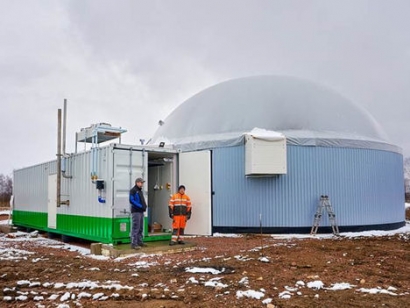
The Vuorenmaa dairy farm has its own biogas plant that produces about 1,200 MWh of biogas per year. Biogas has already been used to produce the electricity and heat needed at the farm, but now the biogas plant has been expanded. Initially, about half of the gas will be refined into biomethane for use in transportation. The fill-up station will be ready by the end of the year, and then the milk truck will start filling up its biogas tank at the farm. At first, there will be a limited supply of biogas available to passenger cars. As the demand grows, the refining capacity can be increased. If all the biogas were to be used by passenger cars, there would be enough for 85 cars to drive 20,000 kilometers a year.
“We have had our own biogas plant for 15 years. Previously, we got heat and electricity from cow manure to meet the needs of our own farm. When it was time to renew the equipment, we decided that we could expand and produce biogas also for transportation. The milk truck will start using the farm’s biogas later this year. Around the same time, a fill-up station for other motorists will be opened …,” Janne Vuorenmaa says.
Valio is aiming to cut milk’s carbon footprint to zero by 2035. This can be achieved by reducing emissions at dairy farms, in transportation and at plants, and by increasing the carbon sinks of fields through carbon farming; Valio and the Baltic Sea Action Group have teamed up to provide training to dairy farmers. The Vuorenmaa farm is one of the carbon farms.
“The Vuorenmaa dairy farm is a good example of how Finnish farmers can solve climate challenges. At the same time, the farms can generate new business. Utilizing manure for biogas production reduces the carbon footprint of milk produced at the farm by one quarter or one fifth, depending on the way it’s calculated,” says Valio’s Juha Nousiainen, SVP, Carbon-neutral milk chain.
Using biogas can reduce as much as 85% of the greenhouse gas emissions created during the life cycle of fuel, compared to diesel fuel.
Manure is an untapped treasure
About 15 million tons of manure is generated in Finland every year. Its odor is familiar to most people around farms, especially in the spring. The manure smell significantly decreases in the biogas process. In addition, the manure nutrients are in a more soluble form than in ordinary manure. When the fertilizer is more effective, less is needed. And there is less nutrient runoff into water systems.
“A network of local operators has emerged around the Vuorenmaa dairy farm. The farm is located close to the Haapavesi cheese plant, so filling up along the milk truck’s route is convenient. Demeca, the supplier of the biogas plant, is a Haapavesi-based company, and so is the H. Vähäaho transport company that collects the milk with its new truck. This is local collaboration at its best,” says Marko Puhto, managing director of Cooperative Osuuskunta Pohjolan Maito.
“We want to create new business opportunities for farmers and elevate the valuation of the sector. Our mission is to improve the profitability of farms and the wellbeing of people and animals. With the coronavirus pandemic, there has been a lot of talk about Finland’s security of supply. What we have here is one way to increase fuel self-sufficiency,” says Demeca’s Sales Director Sami Vinkki.
“Our whole team got excited about the gas vehicle project. Our first milk truck hit the road exactly 60 years ago. It’s great to continue being part of developing the sector,” says H. Vähäaho transport company’s Sami Vähäaho.
The biogas plant has been designed as a part of the farm’s normal nutrient cycling. It increases the farm’s energy self-efficiency, improves nutrient use and decreases the environmental impacts of the nutrients.

